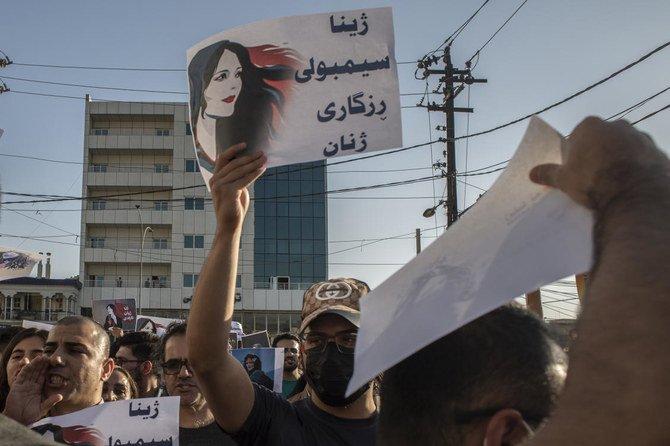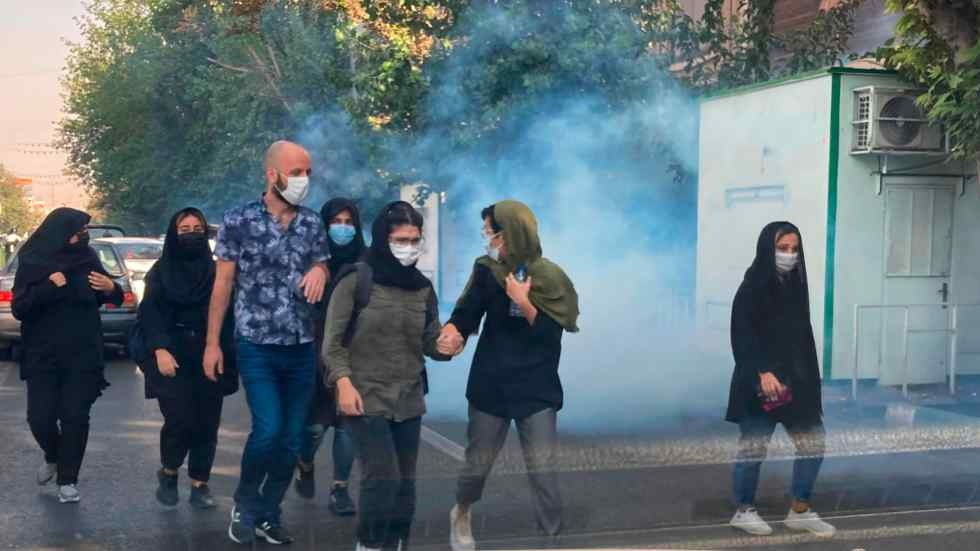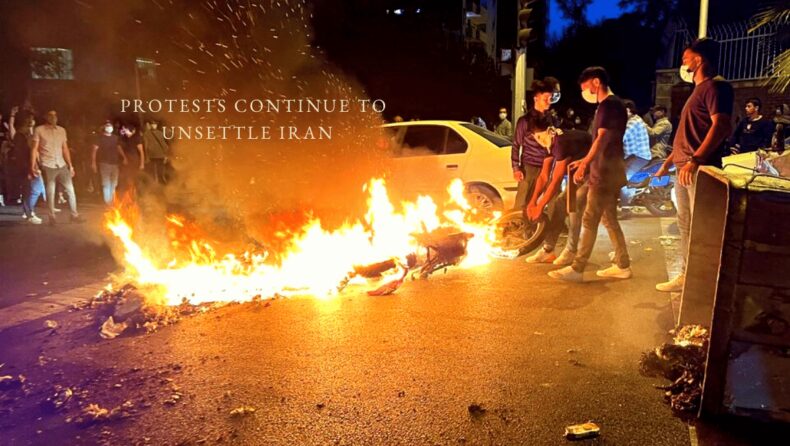Protests in Iran that were sparked by the custodial death of Mahsa Amini, continue for the third week, killing at least 92.

On Saturday, as protests triggered after the custodial death of the 22-year-old Mahsa Amini in police detention reached their third week, demonstrators protested across Iran, and strikes were reported in the country’s Kurdish area.
In yet another display of the long-lasting force of the protests that started more than 2 weeks ago with the demise of Mahsa Amini in police detention for allegedly disobeying the Islamic dress code, student protests erupted across Iran on Saturday, and Kurdish shops went on strike.
The custodial death of Mahsa Amini set off nationwide protests that have killed dozens of people and become the largest display of defiance against Iran’s clerical leadership since 2019.
Social media posts from Iran showed protests taking place in major cities like Tehran, Isfahan, Rasht, and Shiraz. Anti-government demonstrators blocked the main road with a fence taken from the central reservation while chanting, “We would be killed one by one if we don’t unify,” according to videos broadcasted by Tavsir1500 Twitter account.
Protests in Iran: Students stage demonstrations as protests continue for the third week

More than a dozen Iranian institutions reported protests on Saturday as authorities stepped up their crackdown and opened fire on demonstrators in Tehran, the country’s capital. The demonstrations were in response to deadly clashes between protestors and police personnel in Zahedan, the capital of Baluchistan, during which at least 20 people—including three security personnel—were reportedly murdered.
An estimated 19 Sunni Baluchi protestors were killed on Friday in Zahedan, southeast Iran, shocking the nation and marking the first mass murder since the demonstrations started two weeks ago. Demonstrations that started on September 16 got more intense on Friday night.

At numerous universities, students also organized demonstrations. Several people were arrested at Tehran University, according to Tavsir 1500. Some demonstrators were reportedly detained in a square close to the campus, according to the Fars news agency.
All sides of Iranian society, which include ethnic and religious minorities, participated in the protests, many of which called for the overthrow of Supreme Leader Ayatollah Ali Khamenei. They started at Amini’s funeral on September 17 and spread throughout Iran’s 31 provinces.
Despite a violent crackdown that a human rights organization claims have resulted in more than 80 deaths, protests have been staged every night for more than 2 weeks.
They screamed, “Woman, life, freedom” and “Death to the tyrant” in the streets of Saqqez, Amini’s hometown in the Kurdistan region of northwest Iran.
On Saturday, while students protested in Enghelab (Revolution) Square beside Tehran University in the centre of the city to demand the release of detained students, riot police gathered at key intersections throughout the capital. According to the quasi-Fars news agency, police battled with the demonstrators who were yelling chants and detained some of them.
https://iranhr.net/en/articles/5506/
Protests in Iran gather global support
In support of the Iranian demonstrators, people also demonstrated in London, Rome, Madrid, and other Western cities while holding photos of Amini, who passed away three days after being detained by the Islamic Republic’s morality police for “ill-suited dress.”
According to the Iranians for Justice and Human Rights organisation, support demonstrations have been called for in 159 places throughout the world, from Auckland to New York, and Zurich to Seoul. Approximately 1,000 people attended a rally in Rome where six ladies chopped their hair in support.
Around 2,500 individuals, most of them Iranians protested loudly in Trafalgar Square in London. A group of about a dozen individuals in Paris carried Iranian flags and photographs of protest fatalities. In a demonstration attended by many people in Madrid, another Iranian woman chopped off her hair, reflecting protests in Iran wherein women have also been waiving and burning their veils.

The Iranian regime has deployed varied means to repress the ongoing protests including violation of several human rights, violent crackdowns and police brutalities, unlawful detention, suspension of the internet, suppression of the press and the recent act of arresting foreign nationals to deter the protests. According to Iran’s ministry of intelligence, nine foreign nationals were detained in a roundup of “agitators” who were reportedly connected to a surge of anti-government protests that are now in their third week.
Protests in Iran claim 92 lives
According to the Norway-based Iran Human Rights group, the crackdown has claimed at least 92 lives, with its previous estimate being 83. Amnesty International claims to have verified 52 fatalities, however, Iran’s Fars news agency estimates there have been “about 60” fatalities.
At least 41 individuals were killed by Iranian security forces in riots that broke out last week in the town of Zahedan in the province of Sistan-Baluchistan, according to the IHR NGO.
According to Amnesty, it is the deadliest protest in Iran since a brutal crackdown on protests in November 2019 due to a sudden increase in fuel prices that resulted in at least 304 fatalities.
A group of senior British attorneys asked to examine what occurred three years ago raised concerns that perhaps the Iranian regime could ultimately undertake deadly repression of the nature that resulted in as many as 1,500 fatalities after protests in 2019.
https://www.amnesty.org/en/location/middle-east-and-north-africa/iran/report-iran/












